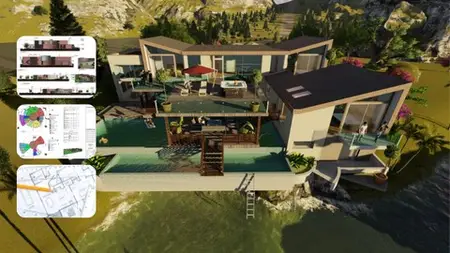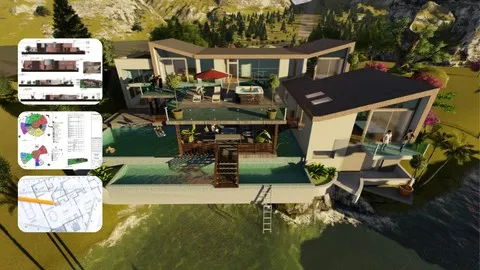Revit Architecture For Beginners: Step-By-Step Training
Published 10/2024
MP4 | Video: h264, 1920x1080 | Audio: AAC, 44.1 KHz
Language: English | Size: 3.51 GB | Duration: 4h 38m
Published 10/2024
MP4 | Video: h264, 1920x1080 | Audio: AAC, 44.1 KHz
Language: English | Size: 3.51 GB | Duration: 4h 38m
From Basics to Advanced Architectural Design | Hands-On BIM Training for Aspiring Architects and Designers
What you'll learn
Equip students with fundamental to advanced skills in Revit Architecture
Enable students to create, modify, and manage architectural projects.
Introduction to Revit Architecture
Basic Building Modeling and Design Techniques Elements
Detailing and Documentation
Advanced Modeling
Visualization and Rendering
Schedules and Quantities
Requirements
Basic Computer Skills: Proficiency in using a computer and navigating operating systems (Windows or Mac). Familiarity with basic file management (saving, opening, and organizing files).
Basic Understanding of Architecture/Design (Recommended but Not Mandatory): Familiarity with architectural design concepts and terminology is helpful but not necessary. Experience with any CAD (Computer-Aided Design) software is an advantage.
Description
"Revit Architecture for Beginners: Step-By-Step Training" is a comprehensive course designed for newcomers to the world of architectural design using Revit. This course provides a structured and practical approach to learning Revit Architecture, starting from the basics and progressing to more advanced concepts. Participants will gain hands-on experience in creating, modifying, and documenting architectural projects. By the end of the course, students will be proficient in using Revit to design and visualize their architectural projects, ensuring they are well-prepared for real-world applications. Key topics include:Introduction to Revit and its user interfaceFundamental tools and commands for architectural designCreating and modifying building elements such as walls, doors, and windowsDeveloping floor plans, elevations, and sectionsGenerating 3D models and visualizationsParticipants will start with an introduction to the Revit interface and its basic tools, learning how to navigate and utilize the software efficiently. The course covers essential topics such as creating and modifying building elements, including walls, doors, windows, and roofs. Students will also learn to develop detailed floor plans, elevations, and sections, ensuring a comprehensive understanding of architectural documentation.The course emphasizes the importance of Building Information Modeling (BIM), teaching students how to leverage Revit's powerful BIM capabilities for improved project coordination and collaboration. Additionally, participants will explore 3D modeling and visualization techniques to bring their designs to life.By the end of the course, students will be proficient in using Revit Architecture to design, document, and visualize architectural projects, preparing them for real-world applications in architecture, interior design, and construction. This course is perfect for aspiring architects, designers, and construction professionals eager to master Revit from the ground up.The course emphasizes practical application through project-based learning, guiding participants in creating 3D models and visualizations to communicate design intent effectively. Essential concepts of Building Information Modeling (BIM) are introduced, highlighting Revit's role in improving project coordination and collaboration across disciplines. By the end of the course, students will have acquired a solid foundation in Revit Architecture, enabling them to create professional-quality architectural designs and documentation.Ideal for aspiring architects, interior designers, and construction professionals, this course equips learners with the skills needed to start using Revit confidently in real-world projects. Whether aiming to enhance career prospects or delve into BIM workflows, this training provides a structured path to mastering Revit's capabilities from scratch.
Overview
Section 1: Introduction
Lecture 1 Introduction
Section 2: DAY 2 - Revit Architecture - Creating Basic Elements Walls:
Lecture 2 Creating Basic Elements Walls: Drawing walls using different methods
Section 3: Use of a comprehensive set of modify commands
Lecture 3 Use of a comprehensive set of modify commands
Section 4: Doors and Windows in Revit, Hiding and Unhiding Elements in Revit & Array
Lecture 4 Doors and Windows in Revit, Hiding and Unhiding Elements in Revit & Array
Section 5: Creating Floors and Ceilings in Revit & Import CAD etc.
Lecture 5 Creating Floors and Ceilings in Revit & Import CAD etc..
Section 6: Placing Components in Revit, Curtain Wall and Types & Architecture Column.
Lecture 6 Placing Components in Revit, Curtain Wall and Types & Architecture Column.
Section 7: Creating Roofs & Its Types
Lecture 7 By understanding these tools and methods, students and professionals can create
Section 8: Creating Stairs in Revit & Its Types, Railing ,Ramp
Lecture 8 Creating Stairs in Revit & Its Types, Railing ,Ramp
Section 9: Creating and managing rooms, areas, model groups, and model lines
Lecture 9 Creating and managing rooms, areas, model groups, and model lines
Section 10: working with sections, section boxes, and openings are essential skills
Lecture 10 working with sections, section boxes, and openings are essential skills
Section 11: focusing on stack walls, annotation, legend creation, schedules and quantities,
Lecture 11 focusing on stack walls, annotation, legend creation, schedules and quantities,
Section 12: Advanced Revit Architecture: Massing, Site Design, and Family Creation Mastery"
Lecture 12 This course will equip students with the advanced skills needed to leverage Revi
Section 13: 'Revit Architecture Excellence: Rendering, Walkthroughs, and Sheet Composition"
Lecture 13 'Revit Architecture Excellence: Rendering, Walkthroughs, and Sheet Composition"
Aspiring Architects: Individuals looking to start a career in architecture and need to learn industry-standard software. Students in architecture programs who want to supplement their education with practical skills.,Professional Architects: Practicing architects seeking to enhance their proficiency in Revit for more efficient project workflows. Architects transitioning from other CAD software to Revit.,Interior Designers: Interior designers who need to create detailed and accurate 3D models and plans. Professionals looking to integrate BIM (Building Information Modeling) into their design process.,Engineering Students and Professionals: Civil, structural, and MEP (Mechanical, Electrical, Plumbing) engineers who collaborate with architects and need to understand Revit models. Engineering students aiming to gain a comprehensive understanding of architectural modeling.



